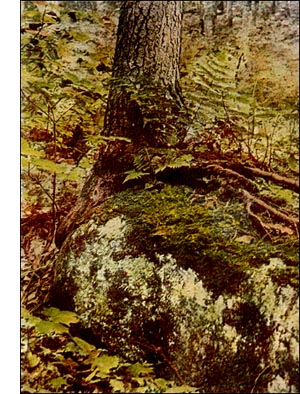Genus Leucobryum
 Genus LEUCOBRYUM, Hampe
Genus LEUCOBRYUM, HampeThe white mosses are found in conspicuous greenish-white cushions about the roots of trees, in woods and on the borders of swamps. The moist cushions are soft and spongy and decidedly greener than the dry, which are so brittle that they can be readily crumbled to dust; and so colourless that they lead one to think they are parasitic or saprophytic plants. The change from brittle to soft is due to large cells in the leaves being filled alternately with water and air.
The pale colour is due to the fact that the cells which contain leaf-green and active cell-contents are relatively small and are hidden between transparent cells many times as great. This arrangement of the cells is a contrivance for protecting the delicate leaf-green bearing cells from the fierce heat of the sun, and for providing a means by which water may be quickly transferred to all parts of the plants.
The walls of these large colourless cells are very thin and are punctured with small holes which communicate with the holes of adjacent cells, so that the moment the plants are moistened, the cells fill with water by capillary attraction. The large cells when filled with water serve as reservoirs to the adjacent small cells, making it possible for the leaf-green to do its work of assimilating plant food. The greater transparency of the water-filled cells makes the leaf-green of the small cells more apparent from the exterior and gives the plants their deeper hue, when wet.
The name Leucobryum, from the Greek; white, and; a moss, was suggested by the pallid colour.
The leaves are lance-shaped with an awl-like apex and a vein occupying the width of the leaf with the exception of a few rows of cells on each side.
The spore-cases are exserted on long pedicels, they are erect or have the summit somewhat inclined, and the base more or less swollen on one side. When dry the wall is grooved lengthwise.
The lids have an awl-like beak and the teeth are two-parted and purple at the base.
The genus is universal, with seventy-four species in all, nine of them being known in North America.
Common White Moss